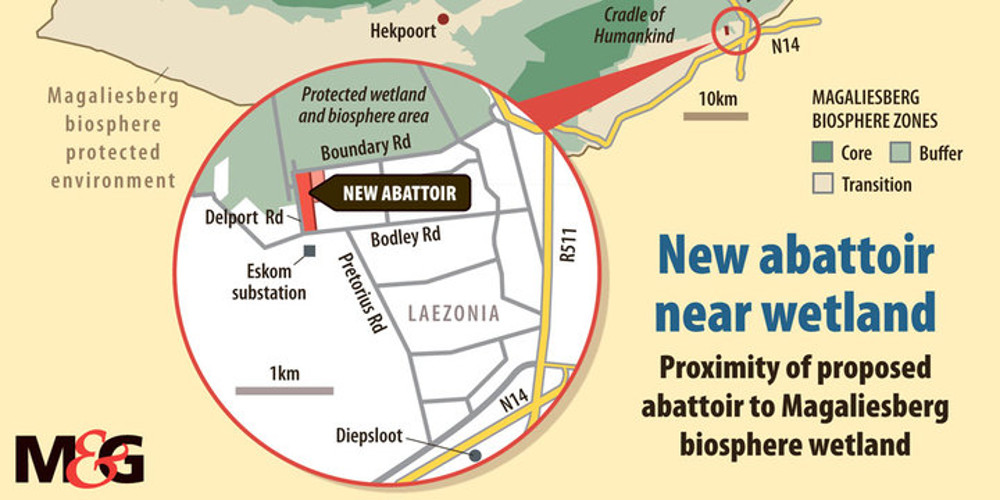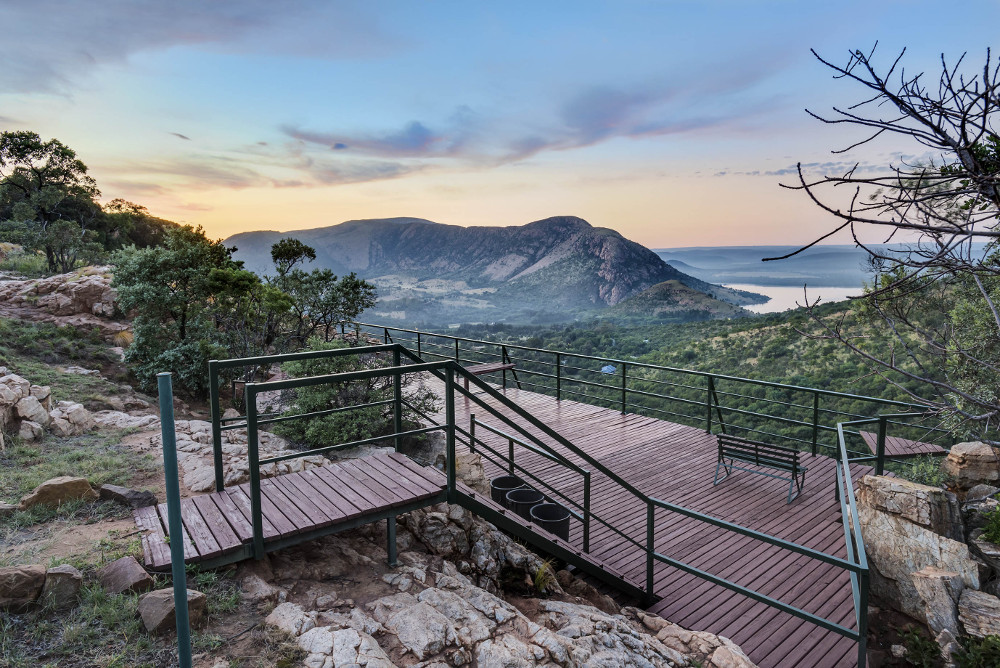Unhealthy proposition: The proposed abattoir will be built in Laezonia
NEWS ANALYSIS
People living in the Magaliesberg Biosphere Reserve have laid criminal charges against the developers of a new abattoir in the area, saying an environmental permit was granted despite plagiarism in the application.
This information came to light after the Mail & Guardian published an article on the Gauteng agriculture and rural development department giving the green light for a new abattoir to be built in Laezonia. This low-density community next to the N14 is a buffer between one of Gauteng’s last natural green spaces and exclusive estates.

[Graphic: John McCann]
The area has long been kept apart for conservation in provincial planning documents. In 2009, the province said Laezonia would be a pilot site for the Gauteng Stewardship Programme. In 2015, the United Nations Education, Scientific and Cultural Organisation granted the nearby Magaliesberg Biosphere Reserve conservation status.
Local government followed this up by saying it would ensure a buffer existed for the biosphere by declaring the areas next to it either nature reserves or protected environments.
In effect, this would create a natural ecosystem extending from the southern part of the Hartbeespoort Dam to Laezonia and then across into the Cradle of Humankind to the west. Together, these areas would form a boundary to the growth of Johannesburg and Tshwane.
Cognisant of this conservation process, developers have been racing to put in applications for new industries before the province carries through its plans. This includes two mines, shopping centres and an abattoir. The Gauteng agriculture department, tasked with ensuring conservation, is also the department that signs off on these applications.
And that is what it did with an application for an abattoir in Laezonia. When built, it will be separated from the Magaliesberg Biosphere by a single, rutted tar road that creates a porous border. Its developers, the Isidwedwe Clothing Primary Co-operative, started the process to get permits in late 2015.
Hyrdo-Geo Engineers, the consultants Isidwedwe appointed to do the impact assessments for the R28-million project, told the M&G at the time that “the proposed activity will create, improve and sustain the livelihood of the beneficiaries and employees involved as well as the community at large”.
Despite Laezonia’s residents objecting to the probable pollution of the river running next to the abattoir, last month the Gauteng agriculture department granted permission for the abattoir and its feedlot to go ahead. It noted that: “This department is of the view that a 200-cattle feedlot will have minimum or no impact, noise and smell wise, on the surrounding environment.”

[Photo: Rustenburg Adventures Tourism]
Documents show both plagiarism and a possible conflict of interest in Isidwedwe’s application.
The plagiarism is the most obvious of the two. Residents’ comments included in the application for environmental authorisation are identical to those contained in an application, by the same consultants, for a feedlot in Potchefstroom in 2015. Questions from the public, and answers from the consultants, are verbatim in both documents.
Taken at random, a question regarding groundwater contamination “making the project owners medically and financially liable” is repeated in both, as is the answer: “The feedlot will be engineered with earth and layer works …”. Both conclude that enough will be done to allay fears raised by residents.
As a result of the plagiarism the Gauteng agriculture department will have been unable to properly weigh the Laezonia community’s concerns versus the benefits of the development.
The application also appears to plagiarise an application for a feedlot 360km away in Mpumalanga, by Royal Haskoning DHV. Last month residents raised this concern with Haskoning and the engineering firm replied that it can “confirm” that “it appears that RHDVH information has been used without proper reference and this may tantamount to plagiarism and to a possible copyright infringement”. It would investigate this further, it said.
The Laezonia community has laid criminal charges against Hydro-Geo Engineers because this plagiarism undermined their ability to object to the development without all the correct facts at hand.
The company did not respond to questions by the time of publication.
A possible conflict of interest is also evident in the Laezonia area. Plots 24 and 25, where the feedlot and abattoir will be built, are owned by Masinya Trading and Projects. Its director is Amanath Soorju, formerly of human resources at the Gauteng department of social development.
This is the department in charge of funding co-operatives, such as the Isidwedwe Primary Clothing Co-operative. The department’s current director of sustainable livelihoods, July Maphosa, recently bought a plot in Laezonia, half a kilometre from the proposed feedlot. That plot was sold to him by Soorju, with deed transfer documents from Windeed showing that he made a R100 000 loss on the transaction.
Perhaps coincidentally, Maphosa’s LinkedIn profile shows that he is interested in slaughterhouses.
Maphosa says Soorju is a “former colleague and friend” and that “unless proven otherwise [Isidwedwe] has never been funded by the department”. He subsequently sends an email showing an occasion when the co-operative was contracted to sew 150 school uniforms, but says this was the only occasion that he has records for.
He says he only found out about the abattoir when he was registered as an affected party, due to his owning land near the proposed site. “My deal with him [Soorju] is in no way … related to the process of building the abattoir as the department and my position have nothing to do with the funding of such an initiative.”